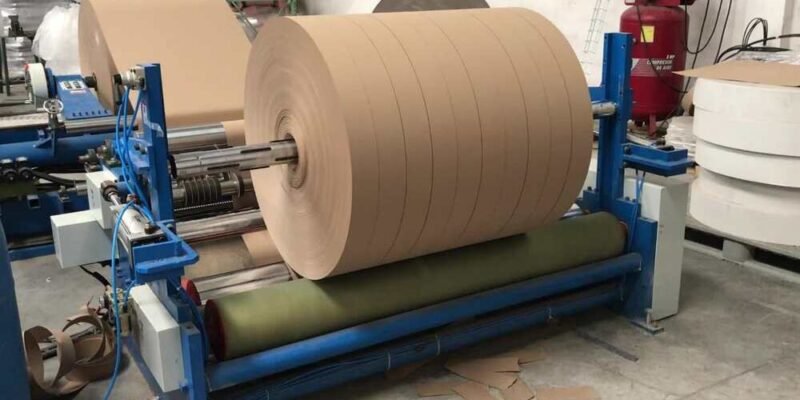Introduction
Production efficiency is paramount in the fast-paced world of paper manufacturing and converting. Paper slitting machines, essential for transforming large rolls of paper into smaller, usable sheets or rolls, play a critical role in this process. Recent advancements in technology have revolutionized the capabilities of these machines, enabling manufacturers to enhance productivity, reduce waste, and improve product quality. This article delves into the latest developments in paper-slitting machines, exploring how they boost production efficiency and meet the industry’s evolving demands.
Understanding Paper Slitting Machines
Paper slitting machines are designed to cut large rolls of paper into smaller widths, making them suitable for various applications, from printing to packaging. The slitting process involves unwinding the large roll, cutting it into strips using sharp blades, and then rewinding the smaller rolls. This equipment is vital for businesses in the paper industry, as it allows for precise cutting and finishing, catering to diverse customer needs.
The paper slitting machine market is estimated to increase from US$571.5 Mn in 2024 to US$772.5 Mn by 2031. The market is projected to record a CAGR of 4.4% during the forecast period from 2024 to 2031, as per the report published by Persistence Market Research. The market is poised for substantial growth, driven by technological advancements, diverse applications in various industries, and a focus on sustainability.
Key Advancements in Paper Slitting Machines
Automation and Control Systems
One of the most significant advancements in paper-sitting machines is the integration of automation and advanced control systems. Modern machines are equipped with sophisticated software that allows for:
- Real-Time Monitoring: In real-time, operators can monitor machine performance, speed, and cutting accuracy. This capability ensures immediate adjustments can be made to optimize production efficiency.
- Automated Settings: Automated controls allow quick adjustments to cutting widths and speeds, minimizing downtime during setup changes. This feature is particularly beneficial in environments where different paper grades and widths are frequently processed.
- Predictive Maintenance: Advanced machines now come with predictive maintenance capabilities. By utilizing sensors and data analytics, manufacturers can anticipate maintenance needs, reducing the risk of unexpected breakdowns and production delays.
Enhanced Cutting Technology
The cutting technology in paper-slitting machines has significantly improved, contributing to higher precision and efficiency. Key advancements include:
- Rotary and Shear Cutting Blades: Modern slitting machines utilize rotary and shear cutting blades that provide clean cuts without damaging the paper. This results in better-quality finished products and reduced waste.
- Adjustable Blade Angles: Adjusting blade angles enhances cutting precision and reduces the likelihood of edge damage. This flexibility is crucial when working with different paper grades and thicknesses.
- High-Speed Cutting: Blade design and motor technology advances allow for higher cutting speeds without sacrificing quality. Increased cutting speeds translate to higher throughput, enabling manufacturers to meet rising demand without additional equipment investment.
Material Handling Improvements
Efficient material handling is essential for optimizing production processes. Recent advancements in paper-slitting machines include:
- Automatic Unloading Systems: New machines feature automatic unloading systems that streamline the transfer of finished rolls to packaging or storage areas. This automation reduces labor costs and minimizes the risk of injuries associated with manual handling.
- Integrated Waste Management: Modern slitting machines incorporate waste management systems that automatically collect and dispose of trimmings and defective materials. This feature keeps the workspace tidy and reduces downtime for cleanup and waste disposal.
- Smart Roll Tracking: Advanced tracking systems enable operators to monitor the status and location of each roll throughout the production process. This capability enhances workflow efficiency and helps prevent material loss or misplacement.
User-Friendly Interfaces
The evolution of user interfaces has significantly improved the operation of paper-slitting machines:
- Touchscreen Controls: Many modern machines have user-friendly touchscreen controls, allowing operators to easily navigate settings, monitor performance, and adjust as needed.
- Remote Access: Some slitting machines now offer remote access capabilities, enabling operators to monitor and control the machine from a distance. This feature is particularly beneficial for manufacturers with multiple machines operating simultaneously.
- Training and Support: Enhanced user interfaces simplify training for new operators. Manufacturers often provide online tutorials and support, ensuring that staff can quickly become proficient in operating the equipment.
Benefits of Advanced Paper Slitting Machines
The advancements in paper-slitting machines translate into numerous benefits for manufacturers, including:
- Increased Production Efficiency: With automation, improved cutting technologies, and enhanced material handling, manufacturers can achieve higher production rates, reduce lead times, and more effectively meet customer demands.
- Cost Reduction: By minimizing waste and optimizing resource utilization, modern slitting machines help manufacturers reduce operational costs. The ability to perform predictive maintenance also lowers repair costs and downtime.
- Improved Product Quality: Enhanced cutting precision and reduced waste contribute to higher-quality finished products. This improvement helps manufacturers maintain customer satisfaction and a competitive advantage in the market.
- Flexibility and Versatility: Advanced slitting machines can handle various paper grades, widths, and thicknesses, allowing manufacturers to adapt quickly to changing market demands and customer preferences.
Future Trends in Paper Slitting Machines
Industry 4.0 Integration
The concept of Industry 4.0, characterized by interconnected systems and smart manufacturing, is poised to revolutionize the paper-slitting industry. Future machines will increasingly integrate with broader manufacturing ecosystems, enabling seamless communication between machines, operators, and supply chain partners. This integration will enhance overall production efficiency and responsiveness.
Sustainable Practices
With growing environmental concerns, manufacturers seek ways to reduce their ecological footprint. Future paper-slitting machines are expected to focus on sustainable practices, including:
- Energy Efficiency: Machines will be designed to consume less energy, aligning with global efforts to reduce energy consumption in manufacturing.
- Recyclable Materials: The production of slitting machines will shift toward using recyclable or eco-friendly materials, contributing to a more sustainable supply chain.
- Waste Reduction: Advanced waste management systems will become even more efficient, helping manufacturers minimize waste generated during slitting.
Continued Innovation in Automation
The trend towards increased automation is expected to continue, with future slitting machines featuring even more sophisticated automated processes. Innovations may include:
- Artificial Intelligence (AI): AI algorithms will optimize cutting processes by analyzing historical data, adjusting parameters in real time, and predicting potential issues before they arise.
- Robotic Integration: Incorporating robotics for material handling and packaging will enhance efficiency and reduce labor costs.
Conclusion
The advancements in paper-slitting machines have transformed the paper manufacturing and converting landscape, significantly boosting production efficiency. With innovations in automation, cutting technology, material handling, and user interfaces, manufacturers can enhance their operational capabilities while meeting the industry’s ever-changing demands. As we look to the future, integrating Industry 4.0 principles, sustainable practices, and continued innovation will further propel the evolution of paper-slitting machines, ensuring they remain an indispensable asset for manufacturers striving for excellence in production efficiency. Embracing these advancements will position companies to thrive in a competitive market while delivering high-quality products that meet the needs of their customers.
Do Read: Snapchat Face Swap Just Got Better: Try This 100% Free AI Face Swap Tool













